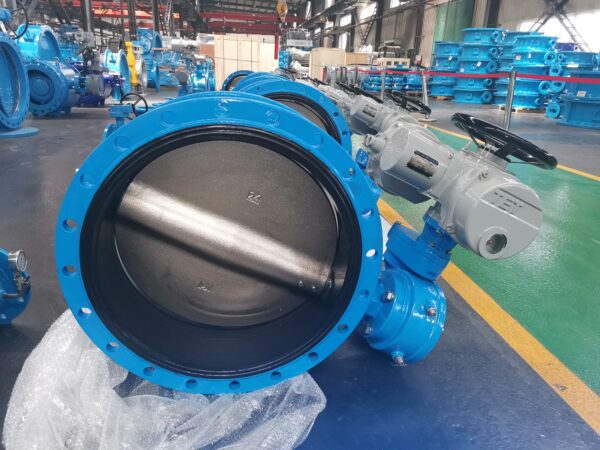A “U-type” butterfly valve, often referred to as a double offset or high-performance butterfly valve, is designed to respond effectively to changes in pressure and flow rate within a fluid handling system. The “U-type” typically denotes the offset configuration of the valve disc.
Here’s how a U-type butterfly valve responds to variations in pressure and flow rate:
- Quick Response to Changes:
- U-type butterfly valves are known for their quick response to changes in pressure and flow rate. The double offset design allows the valve to open and close rapidly, providing dynamic control over fluid flow.
- High Turndown Ratio:
- U-type butterfly valves often have a high turndown ratio, meaning they can effectively control flow rates over a wide range. This flexibility allows the valve to respond to varying pressure and flow conditions by adjusting the disc position for optimal control.
- Precise Modulation:
- The U-type butterfly valve is capable of precise modulation, enabling fine adjustments to flow rates. This level of control allows the valve to respond accurately to changes in pressure, ensuring that the system maintains the desired flow characteristics.
- Stable Operation in Varying Conditions:
- The design of the U-type butterfly valve, with the double offset configuration, contributes to stable operation in varying pressure and flow conditions. This stability is crucial for maintaining control and preventing issues such as water hammer.
- Reduced Wear and Tear:
- The U-type butterfly valve is designed to minimize wear and tear, even in applications with fluctuating pressure and flow rates. This is achieved through materials selection, design features, and considerations such as hardened sealing surfaces.
- Bubble-Tight Shut-off:
- U-type butterfly valves are engineered to provide bubble-tight shut-off, ensuring that the valve seals tightly when closed, u type butterfly valve regardless of pressure variations. This feature is essential for preventing leakage and maintaining system integrity.
- High-Performance Sealing Materials:
- U-type butterfly valves often utilize high-performance sealing materials, such as metal-seated or resilient-seated options. These materials contribute to effective sealing and reduce the likelihood of leakage, especially when pressure and flow conditions change.
- Damping Mechanisms:
- Some U-type butterfly valves may incorporate damping mechanisms to control the speed of disc movement. Damping helps prevent abrupt and uncontrolled movements, ensuring a more stable response to changes in pressure and flow rate.
- Suitability for High-Pressure Applications:
- U-type butterfly valves are suitable for high-pressure applications. The robust construction and sealing mechanisms allow these valves to handle elevated pressures while still providing responsive control over flow.
- Reduced Friction:
- The U-type butterfly valve design minimizes friction between the disc and the seat during operation. Reduced friction contributes to smoother movement and enables the valve to respond efficiently to changes in pressure and flow rate.
- Dynamic Performance in Turbulent Flow:
- U-type butterfly valves exhibit dynamic performance even in turbulent flow conditions. The double offset design helps the valve maintain stability and control under varying flow regimes.
In summary, the U-type butterfly valve is engineered to respond dynamically and effectively to changes in pressure and flow rate. Its design features, quick response time, high turndown ratio, and stable operation make it well-suited for applications where precise control and reliable performance are crucial, even in conditions with varying pressure and flow rates.
